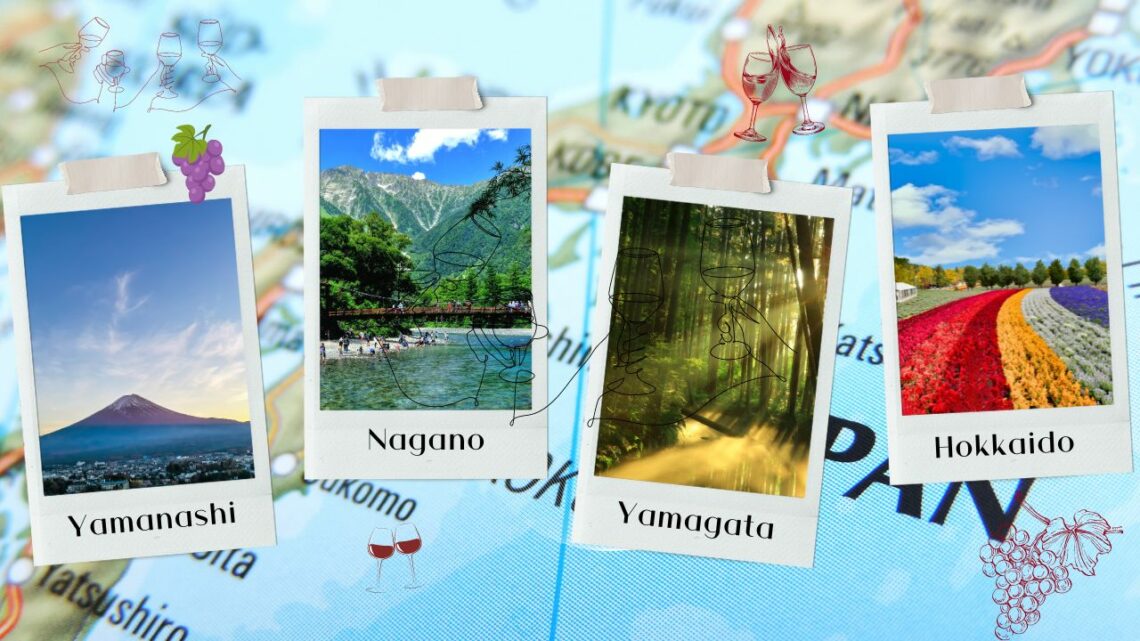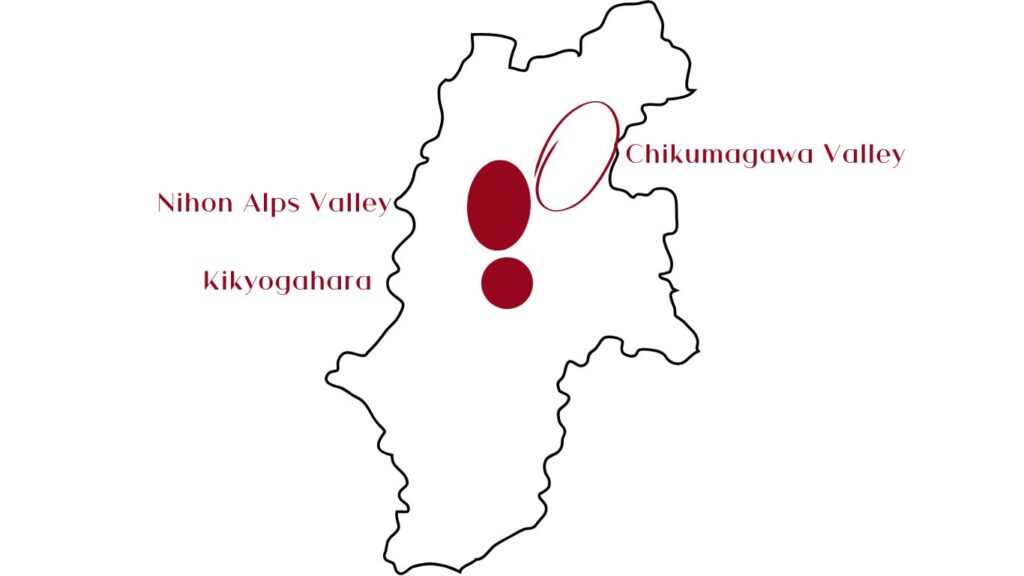
The main wine regions in Japan : A Quick Guide
7 minutes read
Hey wine lovers! Ready to explore the wine regions in Japan? Think of this as a little journey through a country where winemaking is as unique as its sushi rolls.
Japan’s wine scene may be new, but its diversity is unmatched. Stretching over 3,000 km—from snowy Hokkaido in the north to warm, humid Yamanashi in the south—each region brings its own flair to the table.
Thanks to Japan’s high rainfall and tricky climate, winemakers have mastered hybrid grapes, resulting in wines that are light, refreshing, and perfect with Asian cuisine (yes, including sushi).
I’ve broken it down into four main regions: Yamanashi, Nagano, Yamagata, and Hokkaido. So, grab a glass, and let’s dive into the flavors of Japan!

Japan’s winemaking might be new, but it’s packed with variety. From Yamanashi’s crisp Koshu to Hokkaido’s fresh, aromatic whites, each region offers something unique, shaped by its climate and soils. Japanese wines are light, nuanced, and pair beautifully with Asian dishes—proof of an industry that’s evolving quickly and making waves globally.
Yamanashi: Where Japanese Wine Magic Began
If you’re curious about wine regions in Japan, Yamanashi is the perfect place to start.
Known as the birthplace of Japanese wine, Yamanashi is legendary—imagine sipping Koshu with Mount Fuji as your backdrop. Instagram-worthy, right?
Located just west of Tokyo, this region is home to over eighty wineries and produces about 30% of Japan’s wine.
Yamanashi’s volcanic soils, rich in minerals and naturally well-drained, are a winemaker’s dream, especially in a region with heavy rainfall. Combined with mild winters and hot, humid summers, these conditions create wines that are both fresh and complex.
The star here is Koshu, a grape as iconic to Japan as sushi. Known for its light, crisp flavors, Koshu pairs beautifully with Japanese cuisine.
Yamanashi also produces hybrids like Muscat Bailey A and Delaware, alongside European varieties such as Chardonnay, Merlot, and Cabernet Sauvignon.

Nagano: The upcoming star
Next stop: Nagano.
Nestled in central Honshu, Nagano’s vineyards sit at elevations of over 3,000 meters, with cool temperatures and dry, well-drained soils. The high altitude and cooler climate slow down the ripening process, which lets the grape build up their fruity flavours while maintaining a high acidity. Nagano will thus have excellent acidity and complexity.
Nagano is divided into three main valleys, which host around 35 wineries :
- Chikumagawa Valley: This area has just started popping up on the radar with its mix of grape varieties thanks to its varying elevations.
- Kikyogahara: One of Nagano’s oldest wine regions, surrounded by stunning mountains and known for its rich, flavorful grapes
- Nihon Alps Valley: Still figuring things out, but this area shows great potential for some uniquely flavored grapes.

You’ll find hybrids like Ryugan, Concord, and Niagara here, alongside European classics like Merlot and Chardonnay.
With young, innovative winemakers leading the charge, Nagano is quickly becoming the up-and-coming star of the Japanese wines. Don’t miss Kikyogahara Winery (ききょうがはらワイナリー), where you can taste their standout Riesling and Merlot while soaking in the region’s wine culture.

Yamagata-Mogamigawa: Where Tradition Meets Innovation
Yamagata-Mogamigawa in Yamagata Prefecture is a must-visit wine region in Japan.
Located in the Tohoku region, north of Yamanashi and Nagano, Yamagata’s hot summers and cold winters create dramatic temperature swings that help grapes develop high acidity and robust flavors.
The region’s clay-gravel soils, with excellent drainage, further enhance the quality of its wines.
Hybrids like Muscat Bailey A, Niagara, and Delaware dominate here, but European varieties such as Chardonnay, Merlot, and Cabernet Sauvignon are gaining popularity. Winemakers in Yamagata are known for their experimental spirit, making it a fascinating region to explore new wines.
For an insider experience, visit the Yamagata Sake and Wine Fair (Yamagata Nihonichi Bishuken Fair—literally “Yamagata: Japan’s Most Delicious Alcohol Fair”). Alongside Yamagata’s refreshingly crisp sakes, you’ll discover wines bursting with vibrant, fruity flavors, thanks to the region’s unique terroir and use of local fruit.

Hokkaido: The Cool Kid on the Block (and the region I really want to visit inside out!)
Hokkaido is the cool, edgy cousin in Japan’s wine family and the country’s northernmost wine region.
With snowy winters and dry, cool summers, Hokkaido’s climate allows for slow, steady ripening, resulting in highly aromatic, fresh wines. The volcanic ash, loam, and gravel soils add purity and elegance to the wines.
Hokkaido’s winemakers, around 35 in total, focus on cold-resistant hybrids and European classics like Pinot Noir and Chardonnay. The region’s three key areas each bring something distinct :
- Yoichi: Bold, flavorful wines with plenty of depth.
- Sorachi-Furano: Light, refreshing whites that are crisp and lively.
- Tokachi: The Goldilocks of wine regions—Balanced wines with just the right amount of intensity and softness.

Embracing the Future: Japan’s Evolving Wine Regions
The main wine regions in Japan—Yamanashi, Nagano, Hokkaido, and Yamagata—produce 85% of the country’s wine grapes. But the fun doesn’t stop there!
Wineries are popping up in regions like Iwate, Tochigi, Niigata, Kyoto, Osaka, and Hiroshima on Honshu, as well as Oita, Kumamoto, and Miyazaki on Kyushu. While these areas aren’t as well-known as Yamanashi or Nagano, they’re proof of Japan’s growing passion for winemaking.

With around 280 wineries across the country, Japan’s wine industry is evolving rapidly. Winemakers are experimenting with techniques and styles, earning global recognition and international awards that prove the country’s unique approach to winemaking.
Conclusion : Japanese Wine Regions
To sum up : Japan’s winemaking scene is young but incredibly varied, thanks to its wide range of climates and topographies.
Second thing : Japanese winemakers often use hybrid grapes, resulting in wines with delicate and nuanced flavors.
Here’s a quick tour of the wine regions in Japan:
- Yamanashi: The birthplace of Japanese wine, known for its iconic Koshu grapes and mineral-rich volcanic soils. It’s the perfect spot for a wine selfie with Mount Fuji!
- Nagano: An up-and-coming star with high altitudes and cool climates, creating wines with excellent acidity and complexity. Don’t miss valleys like Chikumagawa and Kikyogahara.
- Yamagata-Mogamigawa: Where tradition meets innovation, offering robust wines thanks to significant temperature variations and well-drained soils.
- Hokkaido: Japan’s northernmost island, known for its cool climate and volcanic soils. Expect aromatic and fresh wines from cold-resistant varieties.

Japan’s wine industry is evolving with new wineries popping up across the country, and Japanese wines are gaining global recognition.
The wine regions in Japan are as diverse as its landscapes, and that’s what makes them exciting to explore.
And what do I like most about Japanese wine? The array of flavours and (very light) alcohol. These are wines that are even lighter than Austrian ones and the fact that they use hybrid grapes give a new kick to wine.
Personally, I love how light and refreshing Japanese wines are, which makes them really enjoyable on a hot summer day. That’s my go-to wine when we go out at sea for the day with friends or on a picnic on the beach.
Remember, my quick rule of thumb when it comes to wine and food pairing : what grows together goes together! Koshu’s crispness with sushi or Hokkaido’s Pinot Noir with ramen—it just works.
So why not try a Japanese wine next time you’re ordering sushi?
Where to next?
Discover how winemaking took root in Japan—from its origins in the Meiji era to the modern-day innovations shaping the industry. This post explores the cultural and historical journey of Japanese wine and how regions like Yamanashi became pioneers in the field.
Let’s go straight to the heart: Discover Yamanashi wine region
Explore Japan’s most iconic wine region, Yamanashi, home to Koshu grapes and over 80 wineries. Learn about its unique volcanic soils, mild winters, and why it’s the heart of Japanese winemaking.
Koshu: Japan’s Signature Grape
Dive into the light, crisp flavors of Koshu, Japan’s most famous grape variety. This post explains its history, flavor profile, and why it’s perfect for pairing with Japanese food.







